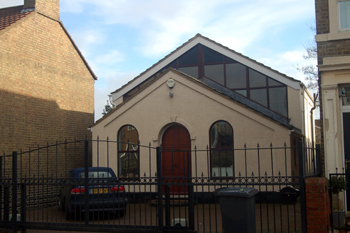
The former Methodist Chapel January 2010
In June 1814 [WE1737-1738 and ST246-247] John Smith of Westoning, yeoman, conveyed a barn "lately converted into a chapel by a society of the people called Methodists residing in or near the parish of Westoning" to Thomas Millard of Flitton, yeoman, for £80. Millard was a member of the society and purchased it on trust that if £50 plus £12 in expenses was given to him by five other members he would convey it to them. Evidently the deal fell through because four years later, in June 1818, Millard conveyed the barn to the Baptists [WE1739]. Where the Methodist met between this date and the building of their new chapel cannot be ascertained from records - the meeting is first included in a Circuit Plan for Dunstable Circuit in 1845.
The next year, 1846, some members of the Baptist meeting left to meet that the house of William Aldridge. In July 1846 Thomas Flower of Dunstable did indeed register a building occupied by farmer William Aldrich for worship [ABN1/2 and 2/385]. Aldridge leased his building to John Cotching of Toddington, butcher, Richard Barton of Toddington, grocer, James Bass of Toddington, bricklayer, Thomas Bligh of Toddington, straw plait dealer, John King of Toddington, sawyer, William Lowens of Toddington, shop keeper, John Odell of Toddington, carpenter, James Walker of Toddington, bricklayer, Thomas Aldridge of Westoning, labourer, James Godfrey of Harlington, straw plait dealer, William gray of Harlington, brickmaker and James Whinnet of Wingfield, farmer in 1846. The building was described as: "all that part brick and part tiled building now used by William Aldridge as a wood barn situate at Westoning and bounded on the front end by the highway leading from Westoning to Ampthill, on the side looking towards Flitwick by a yard and premises now in the occupation of William Aldridge, on the back by another part of the said building now used as a stable and on the side looking towards Toddington by hereditemants now or late belonging to Samuel Mead". The rent was £4 per annum. It was noted that the building was to be used for "Religious worship by the people called Methodists in the connexion established by the late Reverend John Wesley". Thus it seems as if the disgruntled Baptists switched their allegiance to the Methodists.
On Sunday 30th March 1851 a census of all churches, chapels and preaching-houses of every denomination was undertaken in England and Wales. The local results were published by Bedfordshire Historical Records Society in 1975 as Volume 54, edited by D.W.Bushby. The return for the Wesleyan church was made by the exhorter, John Odell, who noted the following pieces of information: the building had 37 free seats, 23 other seats and standing room for 15. That Sunday there had been 39 attending in the afternoon and 63 in the evening. The average for the preceding year had been 45 in the afternoon and 70 in the evening (30th March was an inclement day).
A Wesleyan chapel was registered by Thomas Chope of Dunstable, the circuit minister on 27th August 1863. The Bedfordshire Mercury of 22nd June 1863 describes this chapel's opening two days before: "The ceremony of laying the foundation stones (as they were termed, though the building was very nearly half completed) of a new Wesleyan Chapel in this place was gone through on Tuesday last, in the presence of a large number of spectators. The builders are Messrs. Barber and Higgins, of Dunstable, and the chapel is to be completed at a cost of £183, towards which sum about £120 has already been subscribed, and it is expected to be opened in about a month. We may just state that Mr. George Hopkins (through whose instrumentality the erection has been brought about) has exerted himself in the most praiseworthy manner, and that he is the largest contributor, having given the sum of £15". The chapel opened on 16th July.
In a history of the Dunstable Methodist Circuit published in 1993 the authors note that by the early years of the 20th century membership had declined to ten and remained at that level until 1929 - perhaps the competition from the well established Baptist chapel in Greenfield Road did not help the Methodists.
In 1932 the Wesleyan, Primitive and United Methodists combined to form the Methodist Church of Great Britain. The chapel in Westoning must have picked up members because in 1982 a front annexe was added. Including a hall, kitchen and toilet facilities.
The chapel did not last many more years, however and was sold in 2003. In 2008 the former chapel was again put for sale as a private house [Z449/2/56]. The particulars described the building as "A unique chapel conversion with interesting and versatile accommodation, together with gated off street parking". It comprised a ground floor of: entrance hall 11 feet 8 inches by 4 feet 7 inches; reception room 23 feet 10 inches by 12 feet 9 inches; kitchen 11 feet 8 inches by 9 feet; study 11 feet 8 inches by 6 feet 1 inches; bedroom 11 feet 4 inches by 10 feet 7 inches with en-suite shower room; inner lobby and family bathroom. The first floor comprised a galleried landing, cloakroom and two bedrooms. Sadly, Bedfordshire & Luton Archives & Records Service has no records from the chapel itself.